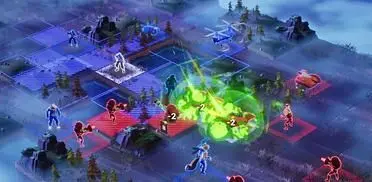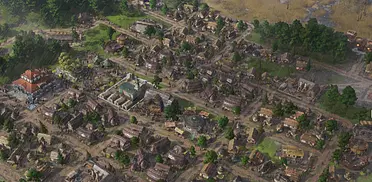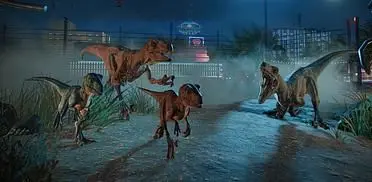It’s not every month we can celebrate the return of a mighty RTS classic like WH40K: Dawn of War. Ahead of the Definitive Edition’s surprise announcement last week, we had the opportunity to chat with Relic Entertainment veteran Philippe Boulle, design director on the project.
Boulle’s writing and game design background helped shape the awesome Dark Crusade expansion. He later went on to work on Dawn of War II’s campaign, the original Space Marine (also getting a remaster this year), Company of Heroes II, and Dawn of War III, which he directed. After a short hiatus, he returned to Relic to work on Age of Empires IV, this Definitive Edition of the original Dawn of War, and an unannounced project. It comes as no surprise he had plenty to share about the fan phenomenon surrounding the first game, his experience working closely with Games Workshop, and under-the-hood changes we wouldn’t notice in the upcoming remaster otherwise.
The following interview has been lightly edited for clarity and conciseness.
Q: This is a project that fans have wanted for a long time if you look at the work the community has done on the original release for two decades. What prompted Games Workshop and Relic to go ‘hey, let’s do this now’ now?
A: Part of it was Relic transitioning from being under the Sega umbrella, looking around and seeing what we could continue to deliver to fans… We had a meeting with Games Workshop. I joke about it as being sort of the Spider-Man meme of the two of us pointing at each other, going ‘What would be cool?’ for a bit. We had a few engineers go in to make sure we still had all the code first. So we figured out we could rebuild it and then we sat down and figured out how we should do it… We both wanted to do it, and we were very happy to continue working with Games Workshop. They’ve been amazing partners for 20 years through thick and thin.
Q: One thing modders kept tinkering with over the years was the HUD size and camera placement when using modern resolutions. There are some mods which tried to fix it, but that also caused other problems. How did you go about that?
A: The default camera is pulled out from roughly 39 meters from the eye of the camera to the point on the ground it’s looking at. We pulled that back to 55 to open it up a little bit, and we have pushed the fog out. We haven’t played with the vision ranges of units. The actual fog of war is the same as in the classic game… If we universally pushed that out, encounters would trigger at different times in the campaign missions and so forth; some of the map design wouldn’t work as well…
If you’re playing Orks and you build three squads of 12 or 15 Ork boys in the original game, they won’t all fit on screen most of the time. Now you can fit them all. You can have your whole base and see it in one screenshot, which is very nice. We just wanted to adjust the camera so that it was what we were trying to deliver originally but taking advantage of modern hardware.
Q: How did you make sure most mods work in the Definitive Edition? Has it all changed internally just enough so it can still accommodate them?
A: How we do it is by installing the mods and testing them and working with modders. What we want out of the box is the mods to be easily installed into the DE. There are one or two installation instruction changes that we’ll need to provide. They won’t take advantage of the new lighting or the new reflection maps, but that will be available if they want to update those things… It’s key to us to respect and honor the work that all those modders had done and to make sure the fan base still has access to that stuff.
Q: Regarding online multiplayer, the original game used GameSpy, which is long gone. Are you looking at direct hosts, peer-to-peer, or is there a big infrastructure in place?
A: It will use the RelicLink backend, which is what drives the multiplayer matchmaking for all the other Dawn of War games, the Company of Heroes games, as well as the Age of Empires games, so that’s a robust system. The classic game was already converted to that when it was added to Steam, but now we’ll be able to integrate more closely. We want to get friend invites working, to make it easier to join matches, and so on… It’s fundamentally a P2P system, but a battle server checks to ensure everybody’s in sync.
Q: When you looked at mods and rebalance patches by the community, have you considered doing some balancing passes for this release?
A: We definitely have been looking at it. What we’re going to do is release with the balance largely as it exists. If we see egregious bugs or things like that, we’ll address them. We want to provide a platform upon which we could do more balance updates if there’s demand. But fan balance patches can still be used.
One of the challenges with the ‘classic edition’ is there are four possible multiplayer pools, so that’s complicated. We’re going to have one multiplayer pool, which will effectively be the Soulstorm multiplayer. We’re setting it up so that we’ll be able to rebalance the MP separately and not affect the campaigns. You’ll still be able to mod the campaigns; it’s just there’ll be two separate data sets… Being able to handle that is one of the reasons we’ve also switched to a 64-bit application. Modders were already running into memory constraints; this will hopefully allow them to do more amazing things.
Q: On the matter of textures and videos, we’ve recently seen a number of bad AI upscales. Those can be pretty good, but others are very bad. People often get this mixed with generative AI, so it can be troublesome. How are you approaching that, or are you just doing everything manually?
A: We’re making sure humans are involved. AI-assisted upscaling is occurring, but those are being done by artists who worked on the original material and have a good eye for each unit’s details and classic feeling. We’ve done rendering improvements in terms of lighting and shadows, reflections… That helps ground the units, but the art assets are the same, and under the hood, it’s the same engine as it was 20 years ago.
Q: Are you adding any new antialiasing options or upscaling like DLSS?
A: I don’t have the specifics in front of me, but there are more options to make it look better. Our tech director for the Definitive Edition is our most experienced rendering programmer. He’s been with Relic for over 20 years and is very familiar with all these problems and working through them… We’ve added a bunch of features we couldn’t support back in the day, and that’s led to an opening up of the art; you can see more of the map, things cast shadows on each other… It feels a little more grounded.
Q: Have you looked at sound and music in the same way?
A: We wanted to take a similar approach. The key thing we didn’t want to lose was the lines coming through with the same classic feel. The unit barks have become such an iconic part of both Dawn of War and the broader Warhammer meme space that we wanted to preserve and honor them as much as possible. We’ve done some tweaks to some recordings that were a little noisy, some rebalance… but we’re still using the original assets.
Q: What’s one change or addition that you’re particularly proud of?
A: Well, why don’t I tell you about noticing things that I hadn’t noticed before? One of the things with pushing the fog back and opening up the camera a bit is there are some situations where it reveals things that I hadn’t seen before… There’s this cinematic of the original campaign where the Chaos Lord and the Chaos Sorcerer are bantering during this ritual and behind them is the whole game map. Originally, it’s almost all obscured with fog, but now you can see more of the game map. So I was watching it and, even though the Chaos Lord was right in front of me being his overly dramatic self, he was also far away on the map doing an idle animation.
Figuring out those new things and finding those things, like correcting typos I made 20 years ago, has been a real joy… Another small thing I’m very happy with is the water. In the original Dawn of War, water was effectively invisible, only noticeable as your units walked through it and made little effects. Now the water has ripples, catches the light, reflects the sky… Suddenly, those levels with lots of water are coming alive.
Q: Things have changed a bit in the console space, especially with Nintendo Switch 2 and its mouse functionality. People are saying it’d be cool to get a lot of real-time strategy titles on that platform. Is that something that you’d like to look at in the future if there’s an interest?
A: I can’t speak about Dawn of War, but I’ll say I had the pleasure of helping put Age of Empires IV on console, working the World’s Edge team from Microsoft and Climax in the UK, and I was quite happy with those results. We also tried a different approach with Company of Heroes 3.
I haven’t seen all the details of the Switch 2, obviously, so there’s a lot of questions there, but the fact there’s an available mouse control opens up possibilities for Relic. What the right game to go there with is, that’s very much an open question.
Q: Now that you have an open channel with Games Workshop again, would you like having the opportunity to work on a fourth game?
A: I can only talk about things that we’ve announced, but we have a long relationship with Games Workshop. I came to Relic to work on GW games. I worked on Dawn of War: Dark Crusade, Dawn of War 2, Dawn of War 3, Space Marine. You know, it’s my happy place. And, you know, I still paint the miniatures and so on, so yeah, but I’m completely focused right now on the Definitive Edition.
Warhammer 40,000: Dawn of War – Definitive Edition is coming to PC (GOG and Steam) later this year. The price tag hasn’t been revealed yet. Stay tuned for updates in the coming months.
For the latest gaming news, follow GameWatcher on BlueSky, check out our videos on YouTube, or give us a like on Facebook. We sometimes include affiliate links in our posts, which grants us a small commission, thank you. Please support independent Games Media. ❤️











